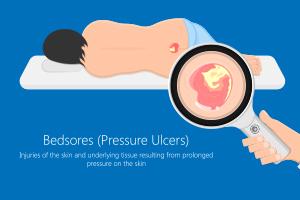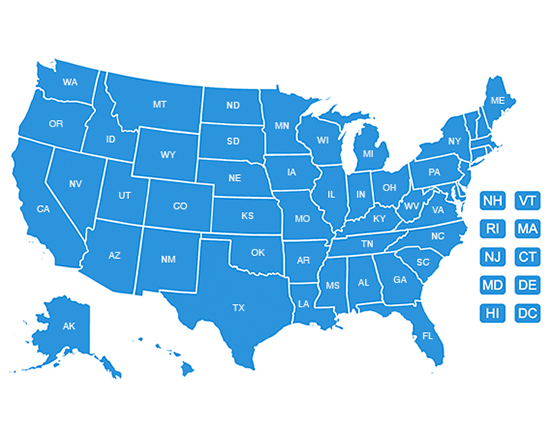The Nursing Home Law Center is committed to providing the legal resources necessary to hold negligent facilities accountable.
Stage 2 Pressure Ulcer

Pressure ulcers are localized injuries when prolonged pressure on one area restricts blood flow and damages the tissue. As the skin cells lose oxygen, they die and break down, forming a pressure sore. If left untreated, a pressure injury can become life-threatening.
Pressure sores mostly happen when people spend long periods in one position, such as when they’re bedridden or in a wheelchair, because of reduced blood flow. This wound is more challenging to see in patients with a darker skin color, making these residents more likely to develop pressure wounds.
This article will define a stage 2 pressure ulcer and outline its legal implications in nursing home negligence.
Stage 2 Pressure Ulcers: In-Depth
Among the four stages of pressure sore development, stage two is the mildest stage, as the tissue is usually still healthy and deeper layers are not damaged. However, unlike the stage one ulcer and the deep tissue injury, the skin is broken.
Pressure sores primarily affect bony parts with little body fat or muscle, such as tailbones, shoulder blades, and heels.
Stage two decubitus ulcers have the following characteristics:
- Partial-thickness skin loss – Stage two pressure injuries only affect the epidermis and a portion of the dermis, the first two layers of skin.
- An open wound or blister – The pressure sore looks like a shallow open sore or a blister field. It may look like a blood filled blister.
- Red or pink wound bed – The wound base still looks like healthy tissue, but it is red or pinkish appearance. This indicates there is no dead tissue yet.
- No dead tissue – There is no necrotic tissue (slough) in the wound bed.
- Possible inflammation – The skin around the pressure sore may look inflamed, red, or swollen. It may also itch.
Most risk factors for developing pressure sores are present in nursing home populations, including age, health conditions such as diabetes, and limited mobility, which leads to constricted blood flow. Residents with stage two ulcers may feel discomfort, pain, tenderness, or burning, and the area may feel warmer to the touch.
Complications
Without fast and effective treatment, stage-two pressure injuries can develop complications. Complications that may occur include:
- Localized infection – Open pressure wounds can become a gateway for bacteria, leading to an infection, including joint infections. They may be foul-smelling and filled with pus.
- Systemic infections – If the bacteria enter the bloodstream, patients can develop a life-threatening systemic infection, which may lead to sepsis, septic shock, and death.
- Progression to severe stages – Untreated stage two ulcers can progress to stages three or four. The following stages damage the tissue further, causing it to die off, while deeper layers of the body become exposed — fat tissue, muscles, tendons, and bones.
- Increased pain – As the skin injury worsens, patients may experience heightened pain and discomfort, which can impact their quality of life and emotional well-being.
Treatment
Constant pressure and friction can prevent existing bed sores from healing, exacerbate them, or cause new sores to develop. Treating pressure sores also prevents new ones from forming. Standard treatment options are focused on promoting wound healing and fighting off infections common with dead skin. These methods are used to treat and prevent ulcers:
- Adequate calories, vitamins, and protein – Proper nutrition helps the skin remain strong and elastic and boosts the body’s immune response. This is crucial to preventing sores in high-risk patients.
- Pressure relief – This includes repositioning the patient regularly to ensure blood supply to all areas and using foam dressings, foam cushions, and a special bed or specially designed mattresses to relieve pressure on certain parts of your body.
- Skincare – Fragile skin is more susceptible to injuries. Nursing home staff must clean the wound with mild soap, moisturize it, and provide proper incontinence care.
- Dressings – Hydrocoloid, alginate, or foam dressings keep the wound moist and clean and promote healing. Nurses should keep the sore covered.
Negligence and Liability in Nursing Homes
If someone you love has a pressure injury, it is possible that inadequate care caused it. Negligence has several aspects, including duty of care, breach of duty, causation, and damages.
Duty of Care
Nursing homes have the duty of care to prevent pressure ulcers. They must adhere to federal and state regulations on managing and preventing pressure sores, such as:
- Creating and implementing skin assessment and care plans for each resident
- Using prevention methods to prevent painful pressure sores
- Having sufficient and adequately trained staff
- Monitoring patients for pressure ulcers
- Treating sores that develop
- Documenting the care properly
- Preventing complications and infections if pressure ulcers do develop
Breach of Duty
When nursing homes fail to provide care according to standards, the duty of care is breached. This can include failure to:
- Create and implement a care plan
- Change positions to reduce risk
- Treat sores
- Provide medical devices such as cushions and mattresses
- Respond to the first signs of infection
- Maintain good hygiene
- Schedule surgery if necessary
Causation and Damages
If the breach results in harm, the facility can be liable for damages. However, the plaintiff must prove that the facility’s negligence directly caused the pressure ulcer or its consequences through actions or inactions.
To prove causation, plaintiffs can use evidence such as:
- Medical records
- Expert opinions
- Video and photographs
- Facility records
- Witness testimonies
Damages are the final element of negligence. They can include medical costs, injuries, bacterial infections, distress, or pain and suffering, and the plaintiff must prove their existence, extent, and cause.
Signs and Symptoms of Neglect Resulting in Pressure Sores
Pressure sores can be a warning sign of neglect.
Nursing home residents may be unwilling or unable to speak up if they’re facing nursing home abuse or neglect. This is why families need to notice the signs and symptoms.
Physical Indicators
Stage two pressure injuries can be a sign of neglect. If someone you care about has a pressure sore, pay attention to other warning signs:
- Malnutrition – Significant, rapid, or unexplained weight loss may indicate neglect. The individual could appear weak and fatigued.
- Dehydration – Signs of dehydration include dry skin, cracked lips, lethargy, and concentrated urine.
- Poor hygiene – Poor hygiene and incontinence care can make ulcers worse. Pay attention to dirt, unwashed clothes, body odor, or skin irritation.
Behavioral Changes
Vulnerable nursing home residents may hesitate to ask for help, fearing retaliation. In other situations, they may have cognitive issues that prevent them from seeking help.
However, specific changes in behavior may point to neglect:
- Withdrawal – Residents might withdraw, avoiding interactions with staff and fellow residents.
- Depression – Signs of neglect can include persistent sadness, loss of interest in activities, changes in appetite, and trouble sleeping.
- Agitation – Irritability, restlessness, or mood swings can indicate a resident’s frustration or discomfort due to neglect or poor care.
The Role of a Nursing Home Injury Lawyer in Pressure Sore Claims
Nursing home injury attorneys can help you investigate the situation, file a claim against the facility, negotiate with the nursing home’s insurer, and, if needed, represent you in court. They will stand by your side and help you protect your loved one’s rights.
Investigation and Evidence Gathering
Nursing home injury lawyers will know how to investigate the circumstances of pressure ulcers, as they have seen the situation many times in their careers. They will help you build a strong case by obtaining evidence such as:
- Medical and facility records
- Interviews with staff and other witnesses
- Photographic evidence
- Expert opinions
- Documentation of staffing levels and facility procedures
Negotiation and Settlement
After building a strong case, the nursing home attorney will file a claim and begin negotiations with the facility and its insurance company. Unfortunately, insurance companies sometimes minimize or negate the damages, which is where an experienced lawyer can help.
They will negotiate with the insurer, present evidence, and build a strategy that increases your chance of fair compensation. Most nursing home injury claims are settled in this phase.
Litigation and Trial Advocacy
If unsatisfied with the settlement offer, your nursing home neglect lawyer can take the case to court. They will represent your interests, question witnesses, counter the opposing arguments, and present evidence.
An experienced lawyer will also provide you with support throughout the process, managing deadlines and other legal procedures so you can concentrate on healing from the trauma your family has experienced.
Seeking Compensation for Damages
In cases involving stage two pressure sores, plaintiffs can recover the following damages:
- Medical expenses – This includes treatment, surgery, and medication costs.
- Pain and suffering – Pressure sores are painful and uncomfortable, and you may receive compensation for your experience.
- Emotional distress – This includes compensation for psychological effects, such as anxiety and depression, as well as a loss of quality of life.
- Punitive damages – Punitive damages serve as a punishment for gross negligence or intentional misconduct. They are rarely awarded.
Secure Expert Legal Counsel!
Patients who have difficulty moving should never have to fear bed sores in a nursing home, as it must prevent these injuries. If the nursing home failed to fulfill this duty and harmed someone you love, you can demand accountability with the help of a nursing home attorney.
Nursing Home Law Center is dedicated solely to these situations, with millions recovered for neglect victims and their families. To learn about your rights and the merits of your case, schedule a free consultation at (800) 926-7565 or complete our contact form.


